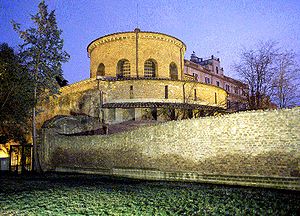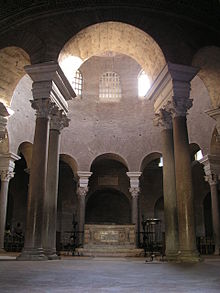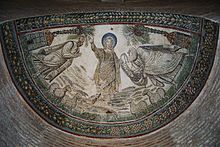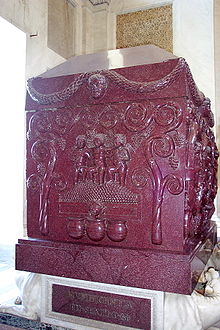- Santa Costanza
-
Santa Costanza is a 4th century church in Rome, Italy, on the Via Nomentana, which runs north-east out of the city, still under its ancient name. According to the traditional view, it was built under Constantine I as a mausoleum for his daughter Constantina (also known as Constantia or Costanza) who died in 354 AD.[1] His other daughter Helena, wife of Julian, who died in 360 AD, was also buried here. In the early Middle Ages it was dedicated as a church to Santa Costanza (Saint Constance).[2]
The fabric of Santa Costanza survives in essentially its original form. What were probably magnificent decoratively coloured stone panels on the walls have gone, no doubt to decorate later buildings, and a few of the mosaics have had some minor damage and incorrect restoration but for the most part it stands in excellent condition as a prime example of early Christian art and architecture. It was built next to, and in connection with, the 4th century basilica of Santa Agnese or Saint Agnes, to which it was attached mid-way along the liturgical north side. Both buildings were constructed over the earlier catacombs where Saint Agnes was buried. Only a long section of the main outer wall of the basilica survives, from the north side and the apse at the eastern end. In the 7th century the present church of Sant'Agnese fuori le mura was built a few metres away, as the Constantinian basilica had decayed and was considered too large to refurbish. One key component which is missing from Santa Costanza is the art of the central dome. But in the sixteenth-century, drawings were taken of this central dome so the artwork can be reconstructed and examined.[3] One key component which is not missing, and is extremely valuable to both the Art and History disciplines, is the large porphyry sarcophagus of Constantina, which was moved in the Renaissance to the Vatican Museums, where it is on display.[3] Overall, most of Santa Costanza has been preserved extremely well.
Recent excavations suggest that this was in fact the second Christian building on the site, and may be some decades later than traditionally thought, and built as a mausoleum for Constantina's sister Helena in the reign of her husband Julian the Apostate. The larger of the two porphyry sarcophagi there would belong to Helena, and the smaller to Constantina, the opposite of what has been traditionally thought. The earlier apsed building of the 330s was probably indeed built for Constantina, but she later had to take second place to her sister; as Constantina's fame as a saintly figure continued in the Middle Ages their roles became reversed in the popular mind.
Contents
History and description
Location
The mausoleum of Constantina was attached to the basilica of Saint Agnese in Rome. This was a common practice in Rome and can be seen the cases of other Roman churches such as the mausoleum of Helena (Constantine's mother, not his daughter), which was attached to the basilica of SS. Marcellino e Pietro.[4] The church is at the side of the Via Nomentana. This is an ancient Roman road, which still exists, which runs north-east from Rome to Nomentum (Ancient Rome) or Mentana. The area was an Imperial family estate, and the sisters were both brought considerable distances to be buried there: Ammianus records that Constantina's body was brought back from Bithynia, and Helena's from Gaul (History XIV: 11, 6).[5] Later legend considerably elaborated Constantina's devotion to Saint Agnes, but it now cannot be determined if this was a factor in the choice of location, although in general terms early Christians believed that their souls benefited from being buried close to martyrs.
Purpose
It was traditionally thought that construction began during the reign of Emperor Constantine I or shortly after, as an early history, the Liber Pontificalis records that Pope Silvester I (d. 335) baptized Constantina and her paternal aunt in a baptistry there, which was assumed to be the structure that survives. But excavations in 1992 discovered an earlier building beneath, and the existing building is now dated to it around 350 AD, in the reign of Helena's husband, the Emperor Julian. Constantina had died in 354, and her sarcophagus was perhaps originally placed in the earlier building.[6]
The structure of Santa Costanza is designed around its purpose. As the mausoleum of Constantine's two daughters, Constantia and Helena, the church was built with a central purpose. Although it is now known as a church, it was not built for this purpose. It was built to be a royal mausoleum. This centralization put "direct physical emphasis on the person or place to be honored"[7] and was popular for mausoleums and places of baptisms at this time.Other roman churches built in a similar fashion and for a similar purpose include The cathedral of Split, built for Diocletian, and the church of St. George in Salonkia built for Galerius.[7]
Design
The structure of Santa Costanza is centralized both in its physical structure and purpose. It has a circular ringed design and domed ceiling. It was built of brick-faced concrete. Its structure is basically two rings supported by columns placed around a vertical central axis. The upper ring sits on the columns while the "lower ring encloses a circular ambulatory whose space flows between the columns into the axial cylinder."[8] This design essentially creates two spaces or two worlds, that of the ambulatory and that of the upper dome. The screens of the ambulatory and inner ring create a dark contrast to the bright upper space of the dome. This contrast of light can be seen in the picture of the main interior. Twelve columns, creating twelve arches, hold up the dome which has twelve windows. This could be a reference to the twelve apostles. This creates a central space which interplays with dark and light. Opposite the entrance in this central space there is "a kind of baldacchino...rises above a porphyry plaque which, below the middle arch of the center room, once seems to have carried the princess's sarcophagus".[9] This is where the sarcophagus of Constantina would have rested. Santa Costanza was also somewhat a new type of building. It was different from the earlier style in that the roof, which had previously been simply done with wood, was instead designed as a dome and vault.[10] The key part of this design is the ambulatory. It is "barrel-vaulted" and is 22.5 meters or 74 feet in diameter.[3] This ambulatory also holds most of the surviving Christian Art found in the church.
The Church Interior
Christian Art
One of the most important historical aspects of Santa Costanza is its use as a prime example of original early Christian art, particularly that of mosaics. The Apses, Central Dome, and Ambulatory give prime examples of early Christian art and architecture.
Mosaics in the apses
The apses of Santa Costanza provide the earliest preserved examples of Christ being presented as the "pantocrator" in Christian art and architecture. Off of the ambulatory there are two apses, each providing an example of Christ as the pantocrator. Both apses have mosaics which are in the original condition and preserved, despite having some damage.[11] Together, they show the beginnings of Christ being shown not only as supremely powerful, but as a connection between heavenly power and the governmental power of man. Both have aspects of Roman Emperor imperial imagery and show the beginnings of Christ's power being extended to the realm of man, in particular in the case of law, government, and rule by divine right.
One of the apses pairs Christ with the ideals of law and justice. He is shown with his apostles Peter and Paul along with a few sheep representing his role as Shepard governing and leading his flock. He is shown giving Peter the scroll representing law, with the inscription, "DOMINUS LEGEM DAT". This translates to "The Lord contains the Law". In addition he is clothed in golden robes further suggesting his power and supremacy. Also, he is shown rising above paradise which further shows his dominance over both heaven and earth.[12]
In the second apse, Christ appears somewhat more humble but still clearly supremely powerful. His robes are not quite as decadent as in the other apse, but still suggest power. He wears a simple tunic but it is purple and gold. This suggests not only holy power, but human power given that purple is the color of royalty and the gold stripes suggestion a connection to the roman emperors. Peter also approaches Christ in supplication, like one would approach the Emperor. This is one of the first examples in Christian art of Christ being portrayed in the same way as the emperor or royalty. It is a concept that would later be prevalent in Christian art and architecture. In this apse Christ is not just portrayed as royalty but as the ruler of the world, of all existence. He sits atop a blue sphere, a clear symbol for the world or universe. From this perch he hands keys to Peter. This is a clear sign of Christ, and the power of heaven, giving authority and holy power to man. It is also important to note that Peter was Rome's first bishop so this meant Roman authority was sanctioned by God. This concept and picture of Christ as the almighty ruler and creator of the world would be the norm in the artwork of later churches, but it first appears here at Santa Costanza.[13]
Mosaics in the ambulatory
The mosaics in the Ambulatory are a stark contrast to those in the apses. They are essentially secular, with panels containing geometric patterns, small heads or figures within compartmented frames, birds with branches of foliage, vases and other objects, and vine patterns with cherubs harvesting and wine-making. This last type of scene also appears on Constantina's sarcophagus, as it does on the ends of the Sarcophagus of Junius Bassus. While the mosaics of the apses have very clear Christian imagery, those in the ambulatory are much more secular and could be considered Dionysiac with their images of grapes, fruit, birds, and mythological figures.[14] This is especially true of the floor mosaics which were similar in style to those in the ambulatory, filled with cupids, birds, and Bacchus and grapevines. This shows the merging of pagan and Christian values in Rome.[15] These mosaics probably represent the sort of decoration found in the Imperial palaces of the period.
The central dome
Despite the fact that the artwork of the central dome no longer exists, a picture of it can still be reconstructed. Sometime between 1538 and 1540, Francesco d'Ollanda made water-color copies of the mosaics in the central dome. From these several Christian images appear including Susanna and the Elders, Tobias, the sacrifice of Cain and Abel,, the sacrifice of Elias on Mount Carmel, possibly Lot receiving the angels, Moses striking the rock for water, and possibly even Noah building the ark. The upper row of mosaics is thought to be scenes from the New Testament since it has the Miracle of the Centurion. These mosaics have caryatids and acanthus-scrolls and a calendar of saints in the upper row.[14] This, in conjunction with the two apses is where the majority of Christian imagery occurs.
Sarcophagi
Two large porphry sarcophagi from the church are now in the Vatican; the larger and more famous (illustrated) in the Vatican Museums, and the smaller in St Peter's itself (left transept). It is now thought that the larger sarcophagus traditionally (and here) related to Constantina may in fact have housed her sister Helena, and the less spectacular one, also removed to the Vatican, was actually Constantina's. The remains from the larger one were placed under the central altar when this was installed in 1256, when the church was consecrated by Pope Alexander IV.[16]
Constantina's sarcophagus has complex symbolic designs, "the surface is dominated by an intricate pattern of stylized vine-stems into which are fitted cherubs...with this scene of Dionysiac exuberance, and the hope of future blessedness which it implies, two peacocks, birds of immorality, are completely in accord".[17] The scene presents a beautiful image of nature and plenty complete with grape vines, sheep and birds. Aside from the natural scene, there are also four portraits including Constantia herself, "on the lid, four graceful portrait heads, one apparently that of Constantina, look calmly out over this assurance that the best is yet to be".[17] The imagery presented of wine and nature are not inherently Christian but could be perceived as such considering the use of wine in the Eucharist. Or they could be perceived as a connection to Bacchus, the God of Wine.[3] This style of sarcophagus would cease to be used in Rome by the end of the fourth century, and this sarcophagus of Constantia is a prime example of this ancient art.[17]
The sarcophagus is massive with the chest measuring 128 cm or 4 ft 23⁄8 in high, 233 cm or 7 ft 71⁄2 in long, and 157 cm or 5 ft 13⁄4 in wide.[3] It is made of porphyry, a hard purple stone. This purple color is a direct connection to royalty and signifies that royalty is entombed within. This stone was reserved by the Romans for use only by the imperial family. It was quarried from only one place, Mons Porphyriticus (Coptos, Egypt), making it even more exclusive.[14] It appears, but can not be certain, that the sarcophagus of Constantina is a copy of that of Constantine I, her father, which is now lost. A piece of what is believed to be his sarcophagus is similar in style and of the same material.[18] A relica in (?) wood has been placed in the church, though to one side; what would presumably have been its original position in the centre of the church is now occupied by the altar.
"The Temple of Bacchus"
In the Seventeenth Century, the Santa Costanza Church was known popularly as "the Temple of Bacchus". Members of the Bentvueghels - a society of mostly Dutch and Flemish artists active in Rome at the time - used to hold rowdy processions to the church and make libations to Bacchus before the porphyry sarcophagus of Constantina (now in the Vatican Museums), which was considered to be his tomb because of its Bacchic motifs. A list of its members may still be seen in one of this church's side chapels. This practice was finally banned by Pope Clement XI in 1720.
See also
- Architecture of ancient Rome
- Early Christian art and architecture
Notes
- ^ John Lowden, Early Christian & Byzantine Art (London: Phaidon Press Limited, 1997), 41.
- ^ Johannes G. Deckers, "Constantine the Great and Early Christian Art" (New Haven: Yale University Press, 2007), 95-96.
- ^ a b c d e John Lowden, Early Christian & Byzantine Art (London: Phaidon Press Limited, 1997), 43.
- ^ Richard Krautheimer, Early Christian and Byzantine Architecture (New York: Penguin Books, 1979), 66.
- ^ Webb, 250-251
- ^ Webb, 249
- ^ a b Michael Gough, The Origins of Christian Art (New York: Praeger Publishers, Inc., 1973), 58.
- ^ William L. MacDonald, Early Christian & Byzantine Architecture (New York: George Braziller, Inc., 1962), 22.
- ^ Richard Krautheimer, Early Christian and Byzantine Architecture (New York: Penguin Books, 1979), 68.
- ^ Walter Lowrie, Monuments of the Early Church (New York: The MacMillan Company, 1923), 139.
- ^ Johannes G. Deckers, "Constantine the Great and Early Christian Art" (New Haven: Yale University Press, 2007), 94.
- ^ Johannes G. Deckers, "Constantine the Great and Early Christian Art" (New Haven: Yale University Press, 2007), 95.
- ^ Johannes G. Deckers, "Constantine the Great and Early Christian Art" (New Haven: Yale University Press, 2007), 96.
- ^ a b c John Beckwith, Early Christian and Byzantine Art (Baltimore: Penguin Books, 1970), 12.
- ^ Marilyn Stokstad, Medieval Art (New York: Harper & Row Publishers, 1986), 29.
- ^ Webb, 251-252
- ^ a b c Robert Milburn, Early Christian Art and Architecture (England: Scolar Press, 1988), 77.
- ^ John Beckwith, Early Christian and Byzantine Art (Baltimore: Penguin Books, 1970), 13.
References
- Webb, Matilda. The churches and catacombs of early Christian Rome: a comprehensive guide, google books
External links
- Constantina - De Imperatoribus Romanis
- Santa Costanza - Santa Costanza Photo Gallery
Categories:- Roman Catholic churches in Rome
- Mausoleums in Italy
- 4th-century architecture
- 4th-century church buildings
Wikimedia Foundation. 2010.






